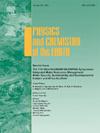Unlocking water sustainability by addressing SDG 6: Macrophyte-based wastewater treatment for agricultural irrigation in Pakistan
IF 4.1
3区 地球科学
Q2 GEOSCIENCES, MULTIDISCIPLINARY
引用次数: 0
Abstract
Pakistan's agriculture, a cornerstone of food security and economic stability, faces severe water scarcity, necessitating sustainable wastewater treatment for irrigation reuse. This study evaluates a small-scale Waste Stabilization Pond (WSP) using Azolla pinnata to treat municipal wastewater in Agha Pora, Multan, aligning with Sustainable Development Goal 6 (SDG 6) for clean water and sanitation. Wastewater parameters—Electrical Conductivity (ECw), Total Dissolved Solids (TDS), Sodium Absorption Ratio (SAR), sodium, chloride, boron, nitrate, bicarbonate, pH, and fecal coliforms—were measured across Hydraulic Retention Times (HRTs) of 3, 5, 7, and 10 days. After 10 days HRT, significant reductions were achieved: ECw (32.2 %), TDS (32.2 %), SAR (42.3 %), sodium (29.9 %), chloride (23.2 %), boron (33.3 %), nitrate (30.9 %), bicarbonate (49.0 %), pH (20.0 %), and fecal coliforms (41.3 %), meeting FAO Irrigation Water Quality Guidelines for restricted irrigation. These findings address gaps in species-specific (Azolla pinnata), region-specific (Pakistan), and HRT optimization research. The low-cost, low-maintenance WSP system offers a scalable solution for wastewater management in developing nations, supporting safe irrigation and freshwater conservation. However, single-location and single-species limitations suggest multi-site, multi-species trials to enhance scalability and broader applicability.
通过实现可持续发展目标6:巴基斯坦基于大型植物的农业灌溉废水处理,实现水的可持续性
巴基斯坦的农业是粮食安全和经济稳定的基石,面临着严重的水资源短缺,需要对废水进行可持续处理,以供灌溉再利用。本研究评估了木尔坦Agha Pora的一个小型废物稳定化池(WSP),该池使用萍萍处理城市污水,符合可持续发展目标6 (SDG 6)关于清洁水和卫生的要求。废水参数——电导率(ECw)、总溶解固形物(TDS)、钠吸收比(SAR)、钠、氯化物、硼、硝酸盐、碳酸氢盐、pH值和粪便大肠菌群——在3、5、7和10天的水力滞留时间(HRTs)中进行了测量。HRT 10天后,ECw(32.2%)、TDS(32.2%)、SAR(42.3%)、钠(29.9%)、氯化物(23.2%)、硼(33.3%)、硝酸盐(30.9%)、碳酸氢盐(49.0%)、pH(20.0%)和粪便大肠菌群(41.3%)的含量显著降低,符合粮农组织限制灌溉的灌溉水质指南。这些发现弥补了物种特异性(Azolla pinnata)、区域特异性(巴基斯坦)和HRT优化研究的空白。低成本、低维护的WSP系统为发展中国家的废水管理提供了可扩展的解决方案,支持安全灌溉和淡水保护。然而,单地点和单物种的限制建议进行多地点、多物种的试验,以提高可扩展性和更广泛的适用性。
本文章由计算机程序翻译,如有差异,请以英文原文为准。
求助全文
约1分钟内获得全文
求助全文
来源期刊

Physics and Chemistry of the Earth
地学-地球科学综合
CiteScore
5.40
自引率
2.70%
发文量
176
审稿时长
31.6 weeks
期刊介绍:
Physics and Chemistry of the Earth is an international interdisciplinary journal for the rapid publication of collections of refereed communications in separate thematic issues, either stemming from scientific meetings, or, especially compiled for the occasion. There is no restriction on the length of articles published in the journal. Physics and Chemistry of the Earth incorporates the separate Parts A, B and C which existed until the end of 2001.
Please note: the Editors are unable to consider submissions that are not invited or linked to a thematic issue. Please do not submit unsolicited papers.
The journal covers the following subject areas:
-Solid Earth and Geodesy:
(geology, geochemistry, tectonophysics, seismology, volcanology, palaeomagnetism and rock magnetism, electromagnetism and potential fields, marine and environmental geosciences as well as geodesy).
-Hydrology, Oceans and Atmosphere:
(hydrology and water resources research, engineering and management, oceanography and oceanic chemistry, shelf, sea, lake and river sciences, meteorology and atmospheric sciences incl. chemistry as well as climatology and glaciology).
-Solar-Terrestrial and Planetary Science:
(solar, heliospheric and solar-planetary sciences, geology, geophysics and atmospheric sciences of planets, satellites and small bodies as well as cosmochemistry and exobiology).
 求助内容:
求助内容: 应助结果提醒方式:
应助结果提醒方式:


